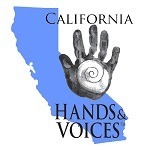by Johanna Wonderly
As the mother of two medically Hard of Hearing, culturally Deaf, daughters, transitioning from IFSP to IEP was a very stressful and scary time for our family. Due to the hard work and awesome planning during the Birth to Three years, my daughter was transitioning at an age appropriate level. The initial transition meeting was not as dramatic as expected. Our local DHH program sent a county representative, along with our current IFSP provider and a School District representative. My daughter, Cassie, 2.5 years old at the time, was very social and chatted away with the strangers in the room.
During the meeting the district representative casually passed me an article which explained essentially that sometimes as children exit Part C services, it is possible that they may not qualify for Part B services and emphasized that we as parents should celebrate that. Every alarm in my body went off. Yes, it seemed to the untrained eye that my daughter’s needs were minimal or even unnecessary but that is only due to all the effective support she has received over the previous two years. That moment I knew I was going to have to be a very strong advocate for my daughter if she was going to receive FAPE (Free and Appropriate Education).
I attended the IFSP to IEP workshop for DHH through the Rowell Family Empowerment and the California Educators of the Deaf and Hard of Hearing conference, downloaded and printed the Special Education Rights and Responsibilities Manual from Disability Rights California, the Deaf Child Bill of Rights, and sought out articles and resources from the Hands and Voices website. With only six months until our IEP meeting I was committed to being as prepared as possible. Every DHH child is eligible for a 504 plan; personally, I would argue that every DHH child is eligible for an IEP as well. The defining difference between a 504 and IEP is IEPs are for students who have a disability that adversely affects educational performance, whereas a 504 is accommodations for a disability. I anticipated that this would be the first issue our district would debate. However, the law specifically states EDUCATIONAL performance, not ACADEMIC performance. In my opinion, every Hard of Hearing child struggles at some level with a language access issue that will adversely affect educational performance in the classroom. Classrooms were not designed to be DHH friendly. The acoustics regularly muddle the sound making it difficult to distinguish the layers of conversation and environmental noise. Responsibility falls on the IEP team to determine LRE, or Least Restrict Environment to provide access based on the child’s preferred communication method(s).
Our daughter’s both have what is considered Mild-Moderate Bilaterial SNHL and as a family we have found that using ASL and spoken English works best for us. Even unaided they can pick up much of their spoken language naturally. However, there are often gaps in their language access depending on various environmental factors and they can tire easily from the mental strain of guessing, and so we rely on ASL to fill in and complete the message. To give a good example of just how much they miss with oral speech and how that translates to the classroom we requested a Functional Listening Evaluation. I knew through my research than when advocating for a specific service in mind for your child, an important lesson is to not request the service but rather the assessment that provides the need for it. There would be no debating the data. The results were incredible. With hearing aids on the assessment showed that while sitting 10 feet away from the speaker, my daughter could recognize only 60% of the message. But how was she to access a conversation or become proficient in a subject with only 60% of the information? This data was essential in showing a need for other methods of communication and/or an Assisted Listening Device (often referred to as an FM system) which would benefit her. For my daughter, this assessment provided the information to prove that the Deaf and Hard of Hearing Classroom to be for her Least Restrictive Environment.
We are lucky as California residents to have other provisions in addition to IDEA’s Special Factors Clause in place to help our hard of hearing daughter and other DHH students like her. Because she speaks, most people assume that mainstream with or without an Assisted Listening Device would be the best place for her. However, her home language is a combination of spoken and signed language. Cal Ed Code Sec. 56345(d) which requires the IEP team to specifically address the communication needs of a DHH student in 4 areas. (1) Primary language: which can be spoken, signed, or both [emphasis added]. (2) availability of language peers. (3) Ongoing Language access to teachers and specialist proficient in the pupil’s language mode. And (4) services necessary to ensure community accessible academic instruction and extracurricular activities.
Armed with this knowledge we were able to create a strong case for the placement we desired. And while we had many emails back and forth having to explain the educational codes and my daughters ADA rights to the district, the day of the IEP meeting, it all went very smoothly. I encourage everyone to take a month or two and dedicate a half hour a night to learning about your rights, and your child’s rights in special education. #DeafCan, they just need to be given the opportunities to thrive. If you haven’t already connected with California Hands and Voices on Facebook, I strongly recommend joining. Its an active page with lots of information. A link to the resources I mentioned above can be found at http://bit.ly/2uicdTT.
